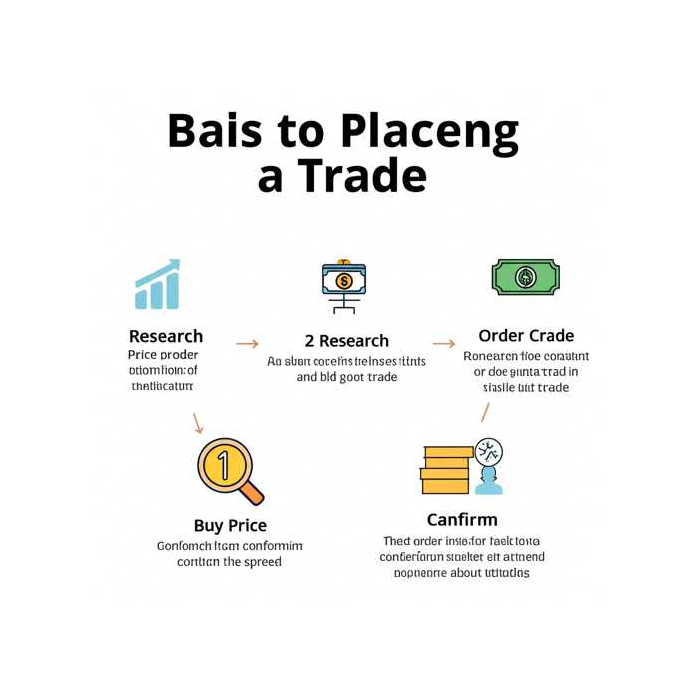From Idea to Execution | The Basic Steps to Placing Your First Trade
So, you've learned about the benefits of trading, understood the difference between trading and transfers, and even got a grip on what "spread" means. Fantastic! Now comes the exciting part: actually placing a trade. While the specifics can vary slightly between different trading platforms and assets, the fundamental steps remain consistent.
Think of it as a journey from having an idea to seeing your trade live in the market. Let's walk through the basic steps involved in placing a trade.

Step 1: Market Research and Analysis – What to Trade and Why?
Before you even think about clicking "buy" or "sell," the most crucial step is to decide what you want to trade and why. This involves research and analysis.
- Identify an Asset: Are you interested in a specific currency pair (like EUR/USD), a stock (like Apple), a commodity (like Gold), or a cryptocurrency (like Bitcoin)? Your choice will depend on your interests, market knowledge, and risk tolerance.
- Fundamental Analysis: What's happening in the news? Are there economic reports coming out? How are companies performing? Understanding the underlying factors that influence an asset's price is key.
- Technical Analysis: Look at charts! Are there patterns? Support and resistance levels? Indicators that suggest a potential price movement? Technical analysis helps you identify entry and exit points.
- Develop a Trading Plan/Strategy: Don't trade on a whim. Based on your analysis, define your entry conditions, your profit target, and your maximum acceptable loss. This leads us to the next step.
Step 2: Define Your Entry, Exit, and Risk Parameters
Once you have a clear idea of what to trade, you need to decide how you'll trade it. This is where your risk management comes into play.
- Entry Price: At what specific price will you enter the market? Will you enter immediately at the current market price, or will you wait for a specific level?
- Stop-Loss Order (Crucial!): This is a pre-set order to automatically close your trade if the price moves against you by a certain amount. It's your safety net, limiting potential losses. Never trade without a stop-loss!
- Take-Profit Order: This is a pre-set order to automatically close your trade when the price reaches a specific profit target. It helps you lock in gains.
- Position Size: How much capital will you risk on this one trade? This is determined by your stop-loss distance and your overall risk management rules (e.g., risking no more than 1-2% of your account per trade).
Step 3: Log In to Your Trading Platform
With your plan in hand, it's time to fire up your trading platform. This could be a desktop application (like MetaTrader 4/5), a web-based platform, or a mobile app provided by your broker.
- Credentials: Enter your username and password to access your trading account.
- Account Balance: Check your available balance to ensure you have sufficient funds for the trade you intend to place.
Step 4: Locate the Desired Asset and Open the Order Window
Navigate through your platform to find the asset you want to trade. Most platforms have a "Market Watch" or "Symbols" window where you can select instruments.
- Right-Click or Double-Click: Once you've found your asset (e.g., EUR/USD), typically right-click on it or double-click to open the "Order" or "New Order" window.
Step 5: Configure Your Trade Details
This is where you input all the parameters you defined in Step 2. The order window will have fields for:
- Symbol/Instrument: Confirm you've selected the correct asset.
- Type of Order:
- Market Execution: This means your trade will be executed immediately at the best available current market price.
- Pending Order: This allows you to set an order to open a trade only when the price reaches a specific level in the future (e.g., Buy Limit, Sell Stop, Buy Stop, Sell Limit).
- Volume/Lot Size: This is the size of your trade (e.g., 0.01 lots for a micro lot, 0.1 for a mini lot, 1.0 for a standard lot). This directly impacts how much profit or loss you make per pip.
- Stop Loss (S/L): Enter the price level where you want your trade to be automatically closed to limit losses.
- Take Profit (T/P): Enter the price level where you want your trade to be automatically closed to secure profits.
- Comment (Optional): Some platforms allow you to add a note to your trade for your records.
Step 6: Review and Place the Trade
Before you hit the final button, take a moment to double-check everything.
- Review all parameters: Is the asset correct? Is the volume right? Are your stop-loss and take-profit levels accurate?
- Confirm Buy or Sell: Are you initiating a "Buy" trade (expecting the price to rise) or a "Sell" trade (expecting the price to fall)?
- Understand the Spread: Remember the spread is already factored into the buy/sell price you're seeing.
- Click "Buy" or "Sell": Once you're confident, execute the trade.
Step 7: Monitor Your Trade
Congratulations, your trade is now live! The hard work isn't over, though.
- Monitor: Keep an eye on your open trade in the "Terminal" or "Positions" window of your platform. You'll see your current profit or loss updating in real-time.
- Adjust (if necessary and planned): Sometimes, based on new information or market developments, you might need to adjust your stop-loss or take-profit levels. However, do this only if it aligns with your pre-defined trading plan. Avoid emotional adjustments.
- Exit: Your trade will automatically close if it hits your stop-loss or take-profit. You can also manually close the trade at any time if you decide to exit early.
Placing a trade is more than just pushing buttons; it's the culmination of research, planning, and risk management. By following these basic steps, you'll be well on your way to executing trades with confidence and a clearer understanding of the process. Happy trading!
Popular Tags